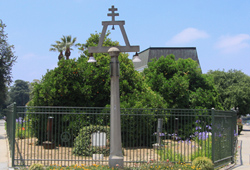Riverside Acts to Protect Parent Navel Orange Tree from Citrus Greening Disease
Published: 04/25/2018
FOR IMMEDIATE RELEASE:
April 25, 2018
Contact:
Phil Pitchford
Communications Officer
951-826-5975
Riverside Acts to Protect Parent Navel Orange Tree from Citrus Greening Disease
Citrus greening, also known as huanglongbing, or HLB, is a threat to citrus across the state
RIVERSIDE, Calif. – The City of Riverside, which traces much of its early prosperity to the birth and expansion of the citrus industry, is moving to protect the historic Parent Navel Orange Tree that played a major role in that growth more than a century ago.
The Parks, Recreation and Community Services Department and researchers from the University of California, Riverside (UCR) will drape a protective cloth over the tree today (4/25) to protect it from the threat of citrus greening disease, also known as huanglongbing (HLB). The disease, which has been found in Riverside, kills citrus trees and threatens the citrus industry across the state.
“The Parent Navel is an iconic symbol of Riverside, as it represents the impact the citrus industry had on our economy,” Mayor Rusty Bailey said. “Riversiders hold this symbol of our citrus heritage very dear, so it is encouraging to see our parks personnel taking a proactive approach.”
Since the first discovery of citrus greening disease in Riverside last year, the City has worked with county and state agricultural agencies to urge all owners of citrus trees in the area to remain vigilant and inspect their citrus trees for signs of the disease. This includes the Parent Navel Orange Tree, which is located within a fenced enclosure at the corner of Arlington and Magnolia Avenue.
There is no known cure or method of immunizing trees against citrus greening disease. As a result, parks personnel, along with UCR researchers, determined that the best defensive measure that can be taken at this time is to isolate the Parent Navel Orange Tree from the Asian citrus psyllid, which spreads the disease.
“Citrus in California is under direct attack from citrus greening disease,” said Mayor Pro Tem Chris MacArthur, whose family has been in the citrus business for decades. “We are encouraging our local citrus owners to be vigilant, and this is a prudent measure for the City to take as well.”
Citrus greening disease has caused significant damage in Florida and was found in other parts of California before being detected in a grapefruit tree in Riverside last July. State and federal officials removed an infected tree from property near the intersection of Chicago and Marlborough avenues to prevent the disease from being spread to other trees by the Asian citrus psyllid.
In addition to the City of Riverside, the California Department of Food and Agriculture (CDFA), the United States Department of Agriculture (USDA) and the Riverside County Agricultural Commissioner’s Office all have worked to educate residents on how to detect citrus greening disease on their own property.
The bacterial disease attacks plants’ vascular system but does not pose a threat to humans or animals. The Asian citrus psyllid can spread the bacteria when the pest moves from one location to another, feeding on citrus trees and other plants. Once a tree is infected there is no cure, and it typically declines and dies within a few years.
Florida first detected the pest in 1998 and the disease in 2005. The University of Florida estimates that the disease causes an average loss of 7,513 jobs per year, and has cost growers $3 billion in lost revenue since it was first detected there. The Asian citrus psyllid was first detected in California in 2008.
For more information about HLB and what to look for, Riverside County residents may call the Agricultural Commissioner’s Office at (951) 955-3045 or CDFA’s toll-free pest hotline at 1-800-491-1899 or visit: www.cdfa.ca.gov/plant/acp/
-30-


